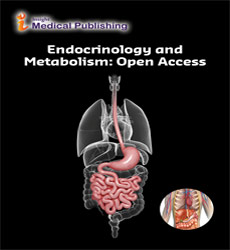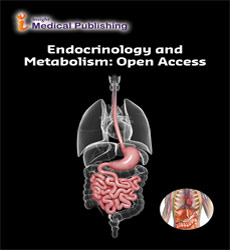Metabolic Syndrome and Cardiovascular Risk: Beyond Obesity and Insulin Resistance
Dario Hana*
Department of Gynecological Endocrinology, School of Medicine in Katowice, Medical University of Silesia, Medyków 14, 40-752 Katowice, Poland
*Corresponding author:
Dario Hana,
Department of Gynecological Endocrinology, School of Medicine in Katowice, Medical University of Silesia, Medyków 14, 40-752 Katowice, Poland,
E-mail: Hana.dario@sum.edu.pl
Received date: February 01, 2025, Manuscript No. ipemoa-25-20740; Editor assigned date: February 03, 2025, PreQC No. ipemoa-25-20740 (PQ); Reviewed date: February 15, 2025, QC No. ipemoa-25-20740; Revised date: February 22, 2025, Manuscript No. ipemoa-25-20740 (R); Published date: February 28, 2025
Citation: Hana D (2025) Metabolic Syndrome and Cardiovascular Risk: Beyond Obesity and Insulin Resistance. Endocrinol Metab Vol.09 No.1:03
Introduction
Metabolic syndrome is a multifaceted clinical condition characterized by a cluster of metabolic abnormalities that significantly elevate the risk of cardiovascular disease (CVD), type 2 diabetes mellitus and all-cause mortality. The core features typically include central obesity, insulin resistance, dyslipidemia, hypertension and glucose intolerance. While obesity and insulin resistance have long been considered the cornerstone of metabolic syndrome, increasing evidence suggests that the underlying pathophysiology extends well beyond these two factors. The syndrome is now recognized as a complex interplay of genetic predisposition, inflammatory pathways, neurohormonal regulation, endothelial dysfunction and environmental influences. Understanding these broader determinants is critical for advancing prevention, risk stratification and therapeutic strategies to combat the global rise in cardiovascular morbidity and mortality [1].
Description
Metabolic syndrome is estimated to affect up to one-third of adults in developed nations, with prevalence increasing worldwide in parallel with rising obesity rates and sedentary lifestyles. Traditionally, its definition has been anchored in the coexistence of abdominal obesity, insulin resistance, hyperglycemia, dyslipidemia characterized by elevated triglycerides and low High-Density Lipoprotein Cholesterol (HDL-C) and elevated blood pressure. These criteria, however, capture only the clinical surface of a much deeper biological disorder that is heterogeneous in presentation and outcomes [2].
The role of visceral adiposity and insulin resistance remains central, but newer insights indicate that adipose tissue is not merely a passive reservoir of energy storage. It functions as an active endocrine organ that secretes adipokines, cytokines and other bioactive molecules that regulate metabolism, inflammation and vascular function.
Dysregulated adipokine secretion, including increased leptin and resistin levels and reduced adiponectin levels, contributes to chronic low-grade inflammation, oxidative stress and impaired endothelial function all of which exacerbate cardiovascular risk independently of obesity itself. This explains why some individuals with normal body mass index (BMI) but excess visceral fat or ectopic fat deposition in the liver, muscle and heart may still develop metabolic syndrome and its complications [1].
Chronic inflammation has emerged as another critical mediator linking metabolic syndrome to cardiovascular disease. Elevated circulating levels of C-Reactive Protein (CRP), InterLeukin-6 (IL-6) and Tumor Necrosis Factor-Alpha (TNF-α) reflect systemic inflammatory activity that accelerates atherosclerotic plaque formation and instability. This pro-inflammatory milieu not only promotes insulin resistance but also directly contributes to vascular injury by impairing nitric oxide availability, increasing vascular stiffness and enhancing pro-thrombotic states. Such findings highlight that metabolic syndrome is not merely a problem of energy balance but also one of immune-metabolic dysregulation. Genetic and epigenetic influences further expand the scope of metabolic syndrome beyond obesity and insulin resistance.
Genome-Wide Association Studies (GWAS) have identified numerous susceptibility loci associated with insulin signaling, lipid metabolism and blood pressure regulation. Epigenetic modifications, including DNA methylation and histone acetylation, mediate gene-environment interactions that predispose individuals to metabolic abnormalities. For instance, prenatal exposure to maternal obesity or undernutrition can induce epigenetic changes that increase offspring susceptibility to metabolic syndrome later in life, demonstrating how early life programming intersects with adult disease [2].
Another dimension that is increasingly recognized is the role of the gut microbiome. Dysbiosis, characterized by reduced microbial diversity and altered composition, is associated with obesity, insulin resistance and systemic inflammation. Certain microbial metabolites, such as short-chain fatty acids and Trimethylamine N-Oxide (TMAO), influence glucose metabolism, lipid profiles and vascular health. Elevated TMAO levels, for example, have been linked to a heightened risk of atherosclerosis and cardiovascular events in individuals with metabolic syndrome. This expanding field suggests that interventions targeting the microbiome, such as dietary modification, prebiotics, probiotics, or even fecal microbiota transplantation, may offer novel approaches to mitigate cardiovascular risk. Neurohormonal mechanisms, particularly involving the Renin-Angiotensin-Aldosterone System (RAAS) and sympathetic nervous system activation, also play a pivotal role. Dysregulation of these pathways contributes to hypertension, vascular remodeling and left ventricular hypertrophy in individuals with metabolic syndrome. Moreover, excess aldosterone activity promotes oxidative stress, insulin resistance and adipose tissue dysfunction, reinforcing the vicious cycle of metabolic and cardiovascular pathology.
Conclusion
Metabolic syndrome represents a global health challenge with profound implications for cardiovascular morbidity and mortality. While obesity and insulin resistance are central components, they represent only part of a much larger picture. Chronic inflammation, genetic predisposition, neurohormonal dysregulation, endothelial dysfunction and gut microbiome alterations all converge to amplify cardiovascular risk in affected individuals.
Recognition of these diverse mechanisms underscores the importance of comprehensive approaches to risk assessment and management, moving beyond traditional weight-centric paradigms. Future strategies will likely emphasize precision medicine, integrating genetic, molecular and metabolic profiling to tailor prevention and therapy. As research continues to unravel the complexity of metabolic syndrome, addressing cardiovascular risk requires a multidisciplinary approach that transcends obesity and insulin resistance, ultimately improving outcomes for millions of individuals worldwide.
Acknowledgement
None.
Conflict of Interest
None.
References
- Recinella L, Orlando G, Ferrante C, Chiavaroli A, Brunetti L, et al. (2020) AdipokinesNew potential therapeutic target for obesity and metabolic, rheumatic, and cardiovascular diseases. Front Physiol 11: 578966.
Google Scholar Cross Ref Indexed at
- Wang D, Zhang Y, Shen C (2020) Research update on the association between SFRP5, an anti-inflammatory adipokine, with obesity, type 2 diabetes mellitus and coronary heart disease. J Cell Mol Med 24(5): 2730-2735.

Open Access Journals
- Aquaculture & Veterinary Science
- Chemistry & Chemical Sciences
- Clinical Sciences
- Engineering
- General Science
- Genetics & Molecular Biology
- Health Care & Nursing
- Immunology & Microbiology
- Materials Science
- Mathematics & Physics
- Medical Sciences
- Neurology & Psychiatry
- Oncology & Cancer Science
- Pharmaceutical Sciences
